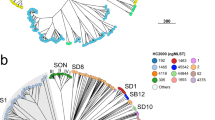Abstract
Epidemiological markers of strains ofSalmonella are classified as major or minor. Major epidemiological markers are determined by chromosomal genes and are not affected by extrachromosomal elements. They are subspecies and serovars. Minor epidemiological markers are either affected by extrachromosomal replicons or have an insufficiently proven genetic stability and are used to subdivide serovars in detailed epidemiological investigations. These minor markers are biovars, phagovars, bacteriocinovars, patterns of resistance to antimicrobial agents, and restriction patterns of chromosomal and plasmid DNA.
Similar content being viewed by others
References
Le Minor, L., Popoff, M.Y. Request for an opinion. Designation ofSalmonella enterica sp. nov., nom. rev., as the type and only species of the genusSalmonella. International Journal of Systematic Bacteriology 1987, 37: 465–468.
Le Minor, L., Véron, M., Popoff, M. Taxonomie desSalmonella. Annales de Microbiologie 1982, 133B: 223–243.
Le Minor, L., Véron, M., Popoff, M. Proposition pour une nomenclature desSalmonella. Annales de Microbiologie 1982, 133B: 245–254.
Le Minor, L., Popoff, M.Y., Laurent, B., Hermant, D. Individualisation d'une septième sous-espéce deSalmonella: S. choleraesuis subsp.indica subsp. nov. Annales de Institut Pasteur/Microbiologie 1986, 137B: 211–217.
InternationalEnterobacteriaceae Subcommittee: Report and Minutes of the Meeting of the InternationalEnterobacteriaceae Subcommittee. Moscow 1966. International Journal of Systematic Bacteriology 1968, 18: 191–196.
Ewing, W.H. Edwards and Ewing's identification ofEnterobacteriaceae. Elsevier Science Publishing Co., New York, 1986.
WHO Collaborating Centre for Reference and Research onSalmonella: Guidelines for the preparation ofSalmonella antisera. Institut Pasteur, Paris, 1986.
Le Minor, L. Lysogénie et classification desSalmonella. International Journal of Systematic Bacteriology 1968, 18: 197–201.
WHO Collaborating Centre for Reference and Research onSalmonella: Antigenic formula ofSalmonella. Institut Pasteur, Paris, 1984.
Popoff, M.Y., Le Minor, L. Expression of antigenic factor O:54 is associated with the presence of a plasmid inSalmonella. Annales de Institut Pasteur/Microbiologie 1985, 136B: 169–179.
Le Minor, L., Coynault, C., Rohde, R., Aleksic, S. Localisation plasmidique du déterminant génétique du caractère atypique “saccharose+” desSalmonella. Annales de Microbiologie 1973, 124B: 295–306.
Le Minor, L., Coynault, C., Pessoa, G. Déterminisme plasmidique du caractère atypique “lactose positif” de souches deS. typhimurim et deS. oranienburg isolées au Brésil lors d'épidémies de 1971 à 1973. Annales de Microbiologie 1974, 125A: 261–285.
Tompkins, L.S., Troup, N., Labigne-Roussel, A., Cohen, M.L. Cloned, random chromosomal sequences as probes to identifySalmonella species. Journal of Infectious Diseases 1986, 154: 156–162.
Fitts, R., Diamond, M., Hamilton, C., Neri, M. DNA-DNA hybridization assay for detection ofSalmonella spp. in foods. Applied and Environmental Microbiology 1983, 46: 1146–1151.
Rubin, F.A., Kopecko, D.J., Noon, K.F., Baron, L.S. Development of a DNA probe to detectSalmonella typhi. Journal of Clinical Microbiology 1985, 22: 600–605.
Shlaes, D.M., Currie-McCumber, C.A. Plasmid analysis in molecular epidemiology: a summary and future directions. Reviews of Infectious Diseases 1986, 8: 738–745.
Wachsmuth, K. Molecular epidemiology of bacterial infections: examples of methodology and of investigations of outbreaks. Reviews of Infectious Diseases 1986, 8: 682–703.
Casalino, M., Comanducci, A., Nicoletti, M., Maimone, F. Stability of plasmid content inSalmonella wien in late phases of the epidemic history. Antimicrobial Agents and Chemotherapy 1984, 25: 499–501.
Threlfall, E.J., Hall, M.L.M., Rowe, B. Salmonella gold-coast from outbreaks of food-poisoning in the British Isles can be differentiated by plasmid profiles. Journal of Hygiene 1986, 97: 115–122.
Philippon, A., Fournier, G., Cornel, E., Paul, G., Le Minor, L., Névot, P. Les β-lactamases desSalmonella résistantes á l'ampicilline. Annales de Microbiologie 1984, 135A: 229–238.
Avril, J.L., Dabernat, H.J., Gerbaud, G.R., Horodniceanu, T., Lambert-Zechovsky, N., Le Minor, S., Mendez, B., Chabbert, Y.A. Groupes d'incompatibilite des plasmides R chez les souches deSalmonella épidémiques. Annales de Microbiologie 1977, 128B: 165–175.
Author information
Authors and Affiliations
Rights and permissions
About this article
Cite this article
Le Minor, L. Typing ofSalmonella species. Eur. J. Clin. Microbiol. Infect. Dis. 7, 214–218 (1988). https://doi.org/10.1007/BF01963091
Issue Date:
DOI: https://doi.org/10.1007/BF01963091




